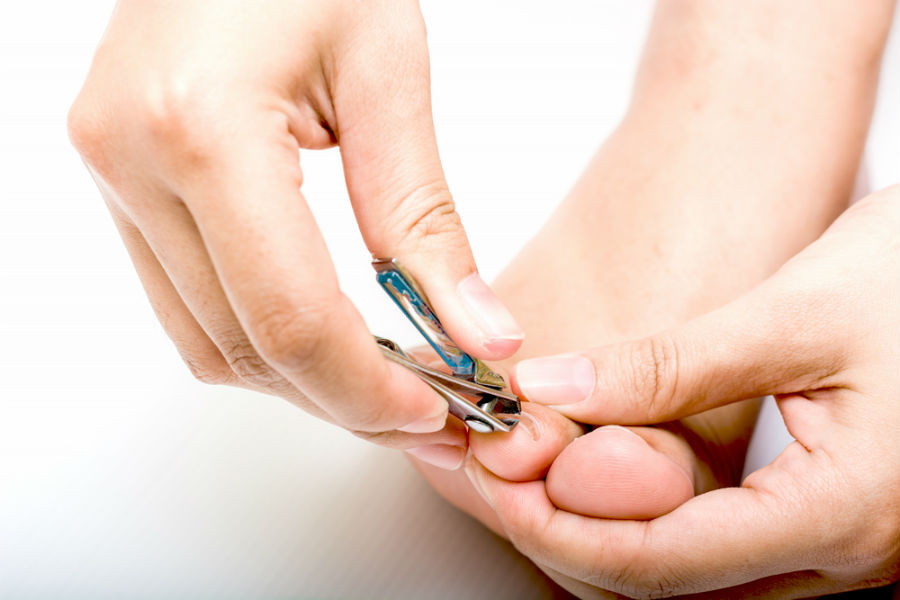Home Remedies for an Ingrown Toenail
Health & Safety Tips
•
May 30, 2018
Reviewed by: Jeffrey Peebles, M.D

Depending on what ails you, especially if it’s not a serious medical issue, utilizing a home remedy may be enough to get you back up on your feet. In many cases, an ingrown toenail, or onychocryptosis, can be treated using just a handful of products you might have lying around the house.
What is an Ingrown Toenail?
An ingrown toenail is exactly what it sounds like – the edge or corner of a toenail, most often the big toe, grows at a curve until it pokes or even penetrates the nail bed. Ingrown toenails are more common in adults, but can affect children as well. Typical causes include wearing footwear that is too tight, experiencing trauma to the toenail or cutting the toenail too short or at an odd angle.
Ingrown toenail symptoms include:
- Pain, especially when putting weight on the foot
- Redness
- Swelling
Ingrown toenails can become infected if left untreated. Once the wound becomes infected, home remedies won’t be an effective treatment method, which is why it’s important to begin treating an ingrown toenail as soon as possible.
Home Remedies
Soaking in Water – Fill a bathtub or bucket with warm water and add either Castile soap or Epsom salt. Soak the affected foot for 15 to 20 minutes per day for several days. This should reduce swelling, provide some pain relief and help fight against bacteria in the wound.
Apple Cider Vinegar – Though there is little scientific backing of the health benefits of apple cider vinegar, many people swear by it as a natural remedy for many ailments, including ingrown toenails. Try applying a diluted mixture to the wound directly with a cotton ball or soaking the foot in a mixture of warm water and a quarter cup of apple cider vinegar for about 20 minutes.
Dental Floss and Cotton Balls – After soaking your foot, place a small piece of a cotton ball or a strip of waxed dental floss under the ingrown edge. If you use cotton balls, it’s recommended you soak them in rubbing alcohol beforehand. This treatment will elevate the nail away from the nail bed so it can grow in the correct direction.
Over-the-Counter Pain Relievers – Taking the recommended dose of either acetaminophen (Tylenol) or ibuprofen (Advil) will help relieve pain and swelling. Many people take these medications in conjunction with soaking.
Antibiotic Ointment – Over-the-counter antibiotic ointments are also useful for fighting against bacteria. Apply it directly to the tender area and place gauze wrap or a bandage over the toenail.
Comfortable Shoes and Socks – It’s recommended you wear more comfortable footwear to prevent toenails from becoming ingrown and to provide relief if you have an existing ingrown toenail. Stay away from high heels and tight tennis shoes and opt for a pair of sandals when you can.
When to See a Doctor
As mentioned previously, an ingrown toenail can be become infected if the nail penetrates the nail bed and it’s left untreated. If you notice pus, severe redness and swelling, throbbing pain, odor or the wound being hot to the touch, it may have become infected.
If home remedies don’t seem to be effective and you’re experiencing any of the symptoms of infection, it may be time to seek professional medical attention. Depending on the severity of the ingrown nail, a doctor might prescribe oral antibiotics or recommend partial or full nail removal.
It’s worth mentioning people with diabetes are at a higher risk for developing complications from an ingrown toenail due to poor blood flow to the feet.
Receive Quick, Quality Health Care With Complete Care
While home remedies can certainly be helpful in some circumstances, nothing can replace quality medical care from caring professionals when you need it most. Complete Care offers emergency and urgent care services for families throughout Texas and Colorado Springs. Whether it’s a painful ingrown toenail or something more severe, Complete Care can offer the relief you’re seeking. Visit us online to find a Complete Care facility near you!
